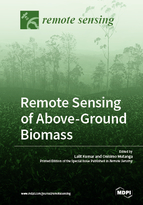Remote Sensing of Above Ground Biomass
A special issue of Remote Sensing (ISSN 2072-4292). This special issue belongs to the section "Forest Remote Sensing".
Deadline for manuscript submissions: closed (28 February 2017) | Viewed by 116086
Special Issue Editors
Interests: environmental modelling; spatial ecology; climate change impacts; remote sensing; GIS; spatial modelling
Special Issues, Collections and Topics in MDPI journals
Interests: remote sensing; land use; environment; vegetation; hyperspectral remote sensing; ecosystem ecology; spatial analysis; climate change impact analysist; vegetation mapping
Special Issues, Collections and Topics in MDPI journals
Special Issue Information
Dear Colleagues,
Vegetation biomass plays a crucial role in understanding and monitoring ecosystem response, and its contribution to the global carbon cycle. The recognition of forests as potential sinks of atmospheric carbon has resulted in numerous studies being conducted in estimating above-ground biomass or carbon stocks across varying scales. In addition, grassland biomass quantification is critical in understanding rangeland productivity as a resource for animal grazing. However, uncertainties in the remote sensing of AGB (Above Ground Biomass) are high due to vegetation structural variations, heterogeneity of landscapes, seasonality and disproportionate data availability, among others. Recent developments in high resolution space-borne and air-borne satellite data have provided an opportunity to better estimate and map AGB across different spatial and temporal scales. The use of drones and UAVs has opened up avenues for super-fine resolution biomass estimation for targeted applications. Recent sensors, such as the Worldview series, now provide meter level spatial resolution, while Sentinel and Landsat 8 provide free data for the whole world, opening up accessibility and more applications of Remote Sensing data, including for biomass estimation.
This Special Issue calls for innovative methods and applications to map AGB at different scales. The range of topics includes, but is not limited to:
- Algorithm development and implementation
- Accuracy assessment
- Scaling issues (local–regional–global biomass mapping)
- Integration of Microwaves (e., LiDAR) and optical sensors
- Forest biomass mapping
- Rangeland productivity and abundance (grass biomass, density, cover)
- Bush encroachment biomass
- Seasonality and long term biomass monitoring
- Climate change impacts and temporal monitoring
Prof. Lalit Kumar
Prof. Onisimo Mutanga
Guest Editors
Manuscript Submission Information
Manuscripts should be submitted online at www.mdpi.com by registering and logging in to this website. Once you are registered, click here to go to the submission form. Manuscripts can be submitted until the deadline. All submissions that pass pre-check are peer-reviewed. Accepted papers will be published continuously in the journal (as soon as accepted) and will be listed together on the special issue website. Research articles, review articles as well as short communications are invited. For planned papers, a title and short abstract (about 100 words) can be sent to the Editorial Office for announcement on this website.
Submitted manuscripts should not have been published previously, nor be under consideration for publication elsewhere (except conference proceedings papers). All manuscripts are thoroughly refereed through a single-blind peer-review process. A guide for authors and other relevant information for submission of manuscripts is available on the Instructions for Authors page. Remote Sensing is an international peer-reviewed open access semimonthly journal published by MDPI.
Please visit the Instructions for Authors page before submitting a manuscript. The Article Processing Charge (APC) for publication in this open access journal is 2700 CHF (Swiss Francs). Submitted papers should be well formatted and use good English. Authors may use MDPI's English editing service prior to publication or during author revisions.
Keywords
- Biomass
- Hyperspectral Remote Sensing
- Multipectral analysis
- LiDAR/Radar
- Forest Biomass
- Grasslands
- Seasonality







